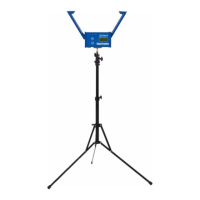1. Introduction
1.1 General
A precise and accurate registration of wind velocity is very significant for a sports branch as
athletics. Let us remind you of the cream of track and field; the sprint races, whereby a record
vitally depends on whether the athlete had the benefit of a tail wind of more than 2m/s or not.
When exceeding this 2m/s limit, a possible record will not be officially acknowledged and ratified.
For long jump and triple jump as well, a precise wind measurement is a conditio sine qua non.
The best-known and ubiquitous method to measure the wind velocity is the pitot tube or a
system which uses a propeller or rotating paddle wheel.
1.2 Disadvantages of a paddle wheel
To measure minor wind velocities, a paddle wheel with a large surface and a very small friction
is required, which at the same time causes certain inertia.
A short and powerful blast of wind suddenly brings the
wheel to a number of revolutions. After the blast of wind
has suddenly come to a standstill, the paddle wheel keeps
on turning, for only the friction of the surrounding air will
slow it down.
Due to the fact that these rotations are calculated within the result, the average wind velocity
will be automatically increased. Moreover, rotating parts are generally subject to wear.
Therefore, a good alternative for this paddle wheel is the TimeTronics’ sonic anemometer or
WindSpeed.

